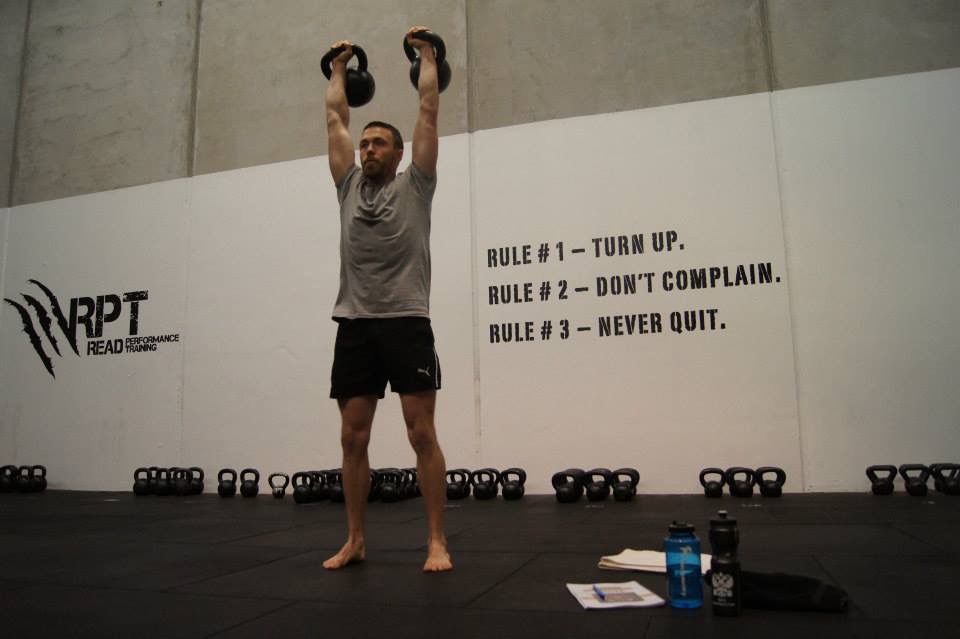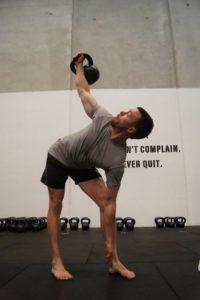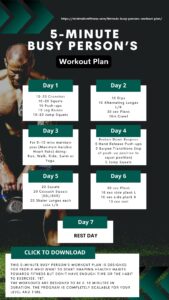The kettlebell press is hands down one of the best exercises you can do for shoulder health and strength.
Straight off the back of last week’s kettlebell clean article, we are tackling the kettlebell press. The reason why it’s my favoured tool for shoulder stability and strength is the simple fact of utility. Let’s break down the kettlebell press, its benefits and some really quick wins you can take away and apply.
What is a Kettlebell Press?
To make it simple, imagine you are lifting a heavy weight straight up overhead, starting from your shoulders. That’s the military press. It’s a classic strength exercise that’s been used for years by soldiers (I was one so I know) and athletes alike. The goal is to lift the weight without cheating, using only the strength in your arms and shoulders.
To do a military press correctly, you need to keep your body perfectly still. No bouncing or swaying allowed! It’s like standing at attention, but with a heavy weight in your hands. This makes it a great exercise for building strength and stability.

Related Posts:
- Master the kettlebell windmill exercise in 3 steps
- 28 Kettlebell Exercises You Must Master
- Learn the kettlebell clean | The Definitive 6 step Guide
- Follow these steps for a better Kettlebell Swing
- Master the kettlebell snatch in 5 steps
- 5 Steps To A Better Turkish Get Up
- Kettlebells: The Ultimate Guide To Strength Training
5 Tips for a better Kettlebell Press
Tip #1 Pick the right kettlebell press for you
If you’re stuck with a single kettlebell you can try:
- Half & Tall Kneeling Press – this helps improve hip stability
- Bottoms Up Press – Using the principles of tension and irradiation you can give the effect of a heavier bell by using the BUP
- Waiters Press – Want to improve that lat engagement on the press? The waiter’s press will do the trick
Using these alternate pressing options will allow you to highlight and improve weaknesses in your kettlebell press and increase the training time you can spend using a single kettlebell. If we’re just looking at the standard kettlebell press though, here are some really quick takeaways and a full video tutorial to help you level up.
How do you do a kettlebell overhead press?
Once you’ve chosen the right press for you the remaining four tips will help you master the kettlebell press:
Tip #2 – Vertical forearm
The rack position must be correct when you’re looking at pressing serious weight. Coming off the back of your kettlebell clean your forearm needs to be in a vertical position before beginning your press. This reduces “muscling” the kettlebell with your shoulder and helps reduce the strain on the rotator cuff.
When you execute the clean and press right, it should feel smooth and stable.
Training Program focused on Kettlebell exercises

Check out our Kettlebell 66 Program! An easy to follow training program for those who like kettlebell exercises.




Tip #3 – Tension starts with the breath
Understanding the importance of the breath throughout the press is critical to maintaining tension, especially when we start to go to heavier kettlebells. This is why the bottoms-up press is such a useful exercise. Knowing when and how to breathe will impact your press in a big way.
Tip #4 – Crush the handle
Another important part of the kettlebell press is the ability to crush the handle during the movement. This allows us to apply tension effectively and gives us another important principle in our arsenal called irradiation. Sherrington’s Law of Irradiation states:
“A muscle working hard recruits the neighbouring muscles, and if they are already part of the action, it amplifies their strength. The neural impulses emitted by the contracting muscle reach other muscles and ‘turn them on’ as an electric current starts a motor.”
Using the other fist as a “trigger” we can gain extra tension and increase neural impulses across the body. Squeezing your glutes and quads at the same time will also help gain that extra tension required for those heavier weights.
Tip #5 – Grease the Groove
Any serious strength practitioner or coach knows that most days you need to practise and not “workout”. When you’re looking at becoming a master of the kettlebell press it’s important to know that somedays you need to press light and easy, particularly with the tension principles above you will notice some days you’re fatigued and the weight simply won’t go. A simple rule of pressing can look like this:
- Spend most of your time at 70-80% of your max effort
- Take easy days when you’re fatigued or the weight simply doesn’t want to move
- Test yourself every 4 to 6 weeks after you’ve put a lot of reps in the bank
For example, if you can push a 28kg for 1-3 reps you would spend most of your time on the 20 and 24kg. Only test the 28 or try a 32 kg press when you’re fresh and your training has shown consistency over a decent period. The old saying of “if you want to press lots you need to press lots” can still apply but lots can mean easy reps to get that money in the bank.
What do you do if you only have a single kettlebell?
If you’ve got a kettlebell, you’ve got a gym. Just because you have a single kettlebell doesn’t mean you can’t improve strength and stability past the number on the bell. This is where the utility and range of options when it comes to the kettlebell press really shine.
What is a good kettlebell press?
A good kettlebell press is one that doesn’t leave you injured. With the weight being positioned on the back of your wrist it is slightly different to the shoulder press and overhead press with a dumbbell.
For men, pressing 10+ repetitions of a single 24kg kettlebell or a 20kg if your a lighter individual is a good point to aim for. For women, 5-10 repetitions at 12kg or 16kg is a worthy goal to start with. If you really want to push it, check out my strength standards.
